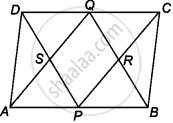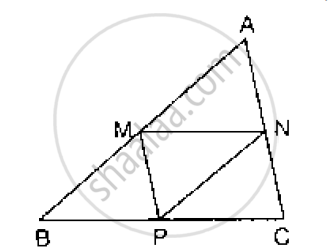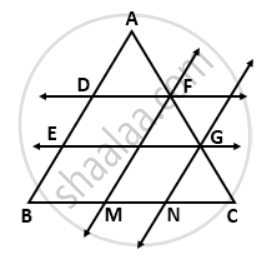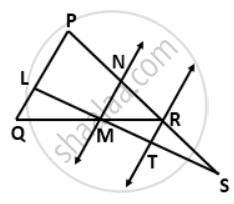Advertisements
Advertisements
प्रश्न
P and Q are the mid-points of the opposite sides AB and CD of a parallelogram ABCD. AQ intersects DP at S and BQ intersects CP at R. Show that PRQS is a parallelogram.
उत्तर
Given: In a parallelogram ABCD, P and Q are the mid-points of AS and CD, respectively.
To show: PRQS is a parallelogram.
Proof: Since, ABCD is a parallelogram.
AB || CD
⇒ AP || QC
Also, AB = DC

`1/2`AB = `1/2`DC ...[Dividing both sides by 2]
⇒ AP = QC ...[Since, P and Q are the mid-points of AB and DC]
Now, AP || QC and AP = QC
Thus, APCQ is a parallelogram.
∴ AQ || PC or SQ || PR ...(i)
Again, AB || DC or BP || DQ
Also, AB = DC
⇒ `1/2`AB = `1/2`DC ...[Dividing both sides by 2]
⇒ BP = QD ...[Since, P and Q are the mid-points of AB and DC]
Now, BP || QD and BP = QD
So, BPDQ is a parallelogram.
∴ PD || BQ or PS || QR ...(ii)
From equations (i) and (ii),
SQ || RP and PS || QR
So, PRQS is a parallelogram.
Hence proved.
APPEARS IN
संबंधित प्रश्न
ABCD is a rhombus and P, Q, R and S are the mid-points of the sides AB, BC, CD and DA respectively. Show that the quadrilateral PQRS is a rectangle.
In Fig. below, M, N and P are the mid-points of AB, AC and BC respectively. If MN = 3 cm, NP = 3.5 cm and MP = 2.5 cm, calculate BC, AB and AC.

The side AC of a triangle ABC is produced to point E so that CE = AC. D is the mid-point of BC and ED produced meets AB at F. Lines through D and C are drawn parallel to AB which meet AC at point P and EF at point R respectively.
Prove that:
- 3DF = EF
- 4CR = AB
If the quadrilateral formed by joining the mid-points of the adjacent sides of quadrilateral ABCD is a rectangle,
show that the diagonals AC and BD intersect at the right angle.
In parallelogram ABCD, P is the mid-point of DC. Q is a point on AC such that CQ = `(1)/(4)"AC"`. PQ produced meets BC at R. Prove that
(i) R is the mid-point of BC, and
(ii) PR = `(1)/(2)"DB"`.
In ΔABC, the medians BE and CD are produced to the points P and Q respectively such that BE = EP and CD = DQ. Prove that: A is the mid-point of PQ.
In AABC, D and E are two points on the side AB such that AD = DE = EB. Through D and E, lines are drawn parallel to BC which meet the side AC at points F and G respectively. Through F and G, lines are drawn parallel to AB which meet the side BC at points M and N respectively. Prove that BM = MN = NC.
In ΔABC, D and E are the midpoints of the sides AB and AC respectively. F is any point on the side BC. If DE intersects AF at P show that DP = PE.
In the given figure, PS = 3RS. M is the midpoint of QR. If TR || MN || QP, then prove that:
RT = `(1)/(3)"PQ"`
E and F are respectively the mid-points of the non-parallel sides AD and BC of a trapezium ABCD. Prove that EF || AB and EF = `1/2` (AB + CD).
[Hint: Join BE and produce it to meet CD produced at G.]
